Issue # 97: No Waffling on My Preference
A Brief History of Belgian Waffles, Lies! Lies! Lies! Plus a Recipe for Gaufres de Liège
I’m writing from Europe. Landed yesterday morning, Tuesday, so it must be Belgium. In fact, it’s Brussels, where in our first few hours we had already eaten our share of waffles, frites (twice), and several different chocolates. Many other things were also consumed—60-day aged côte de boeuf, a selection of cheeses, some natural wines. Time to move on. Today, Liège and Bruges. Stay tuned for future dispatches from our travels over the next ten days.—Mitchell
I can’t say for sure, but it felt like Belgian waffles (gaufres in French) hit the Toronto brunch scene hard in the late 1970s and early 1980s. At least, that’s when I recall starting to see whole sections of menus devoted to them. Admittedly, I was only just becoming a sentient teen aware of my surroundings. And oversized waffles covered in fresh fruit and whipped cream certainly would have stood out to me.
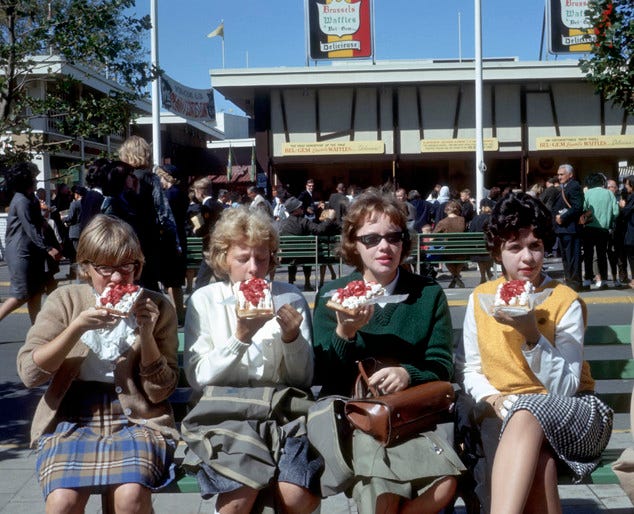
According to the Internet—always a dubious source of facts, especially about food history—the first Belgian waffles were likely introduced to the US in 1962 at the World’s Fair in Seattle. But they really took off two years later at the New York City World’s Fair, where Belgian Maurice Vermersch and his family opened a kiosk that served deeply dimpled waffles covered in fresh fruit that became so popular, eventually they needed to hire ten people just to slice strawberries.
Timing wise, that sounds about right. Before the Internet and social media, it could take a dozen or more years for a popular dish to find its way from New York City onto menus in Toronto. These days it feels like menu trends travel at the speed of light. By 1988, when I worked as a brunch cook at a popular Toronto bistro, I made dozens of Belgian waffles every Sunday. We ran a waffle special each week.
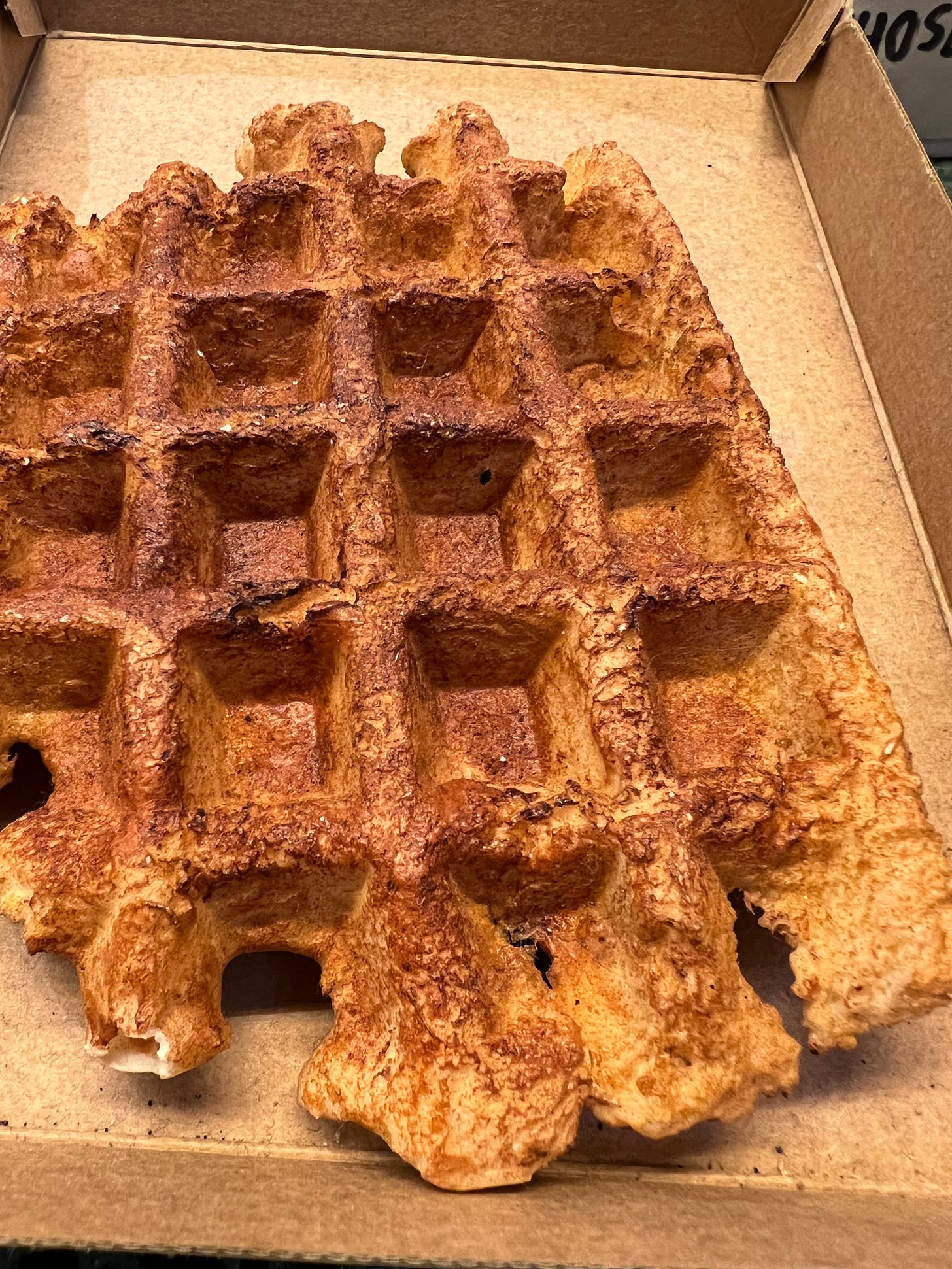
What I didn’t realize until I went to Belgium for the first time in 1990, is that Maurice and everyone since lied to Americans. For starters, there isn’t only one style of waffle that’s known throughout the country of Belgium. There are two. Each style is associated with and named for the town where it is most popular. What we know as a Belgian waffle is actually closest to a Brussels waffle, light, airy, and crisp. The Vermersch clan knowingly conspired to deceive, assuming few Americans would have any idea where Brussels was. (I’d beg to differ, since I think people were already familiar with the tiny green cabbages we call Brussels sprouts.) They called theirs Belgian waffles to make them more approachable.
Meanwhile, the other waffle, the one associated with the town of Liège, has largely been kept a secret. Perhaps no Liègeois has ever been able to afford a booth at a World’s Fair? In my opinion, Liège waffles are in fact the superior waffle of the two. Dense and sweet, these hand-held numbers are a comforting street food, a truly remarkable treat. Unlike their Brussels cousins, which are really not much more than pancake batter (usually from a mix) cooked in a deeply dimpled iron and dolled up with different toppings, Gaufres de Liège are hefty and austere. They have a pleasant crunch from caramelized sugar on the outside and pearled sugar on the inside. The first one I ate on that first visit to Belgium was a revelation.
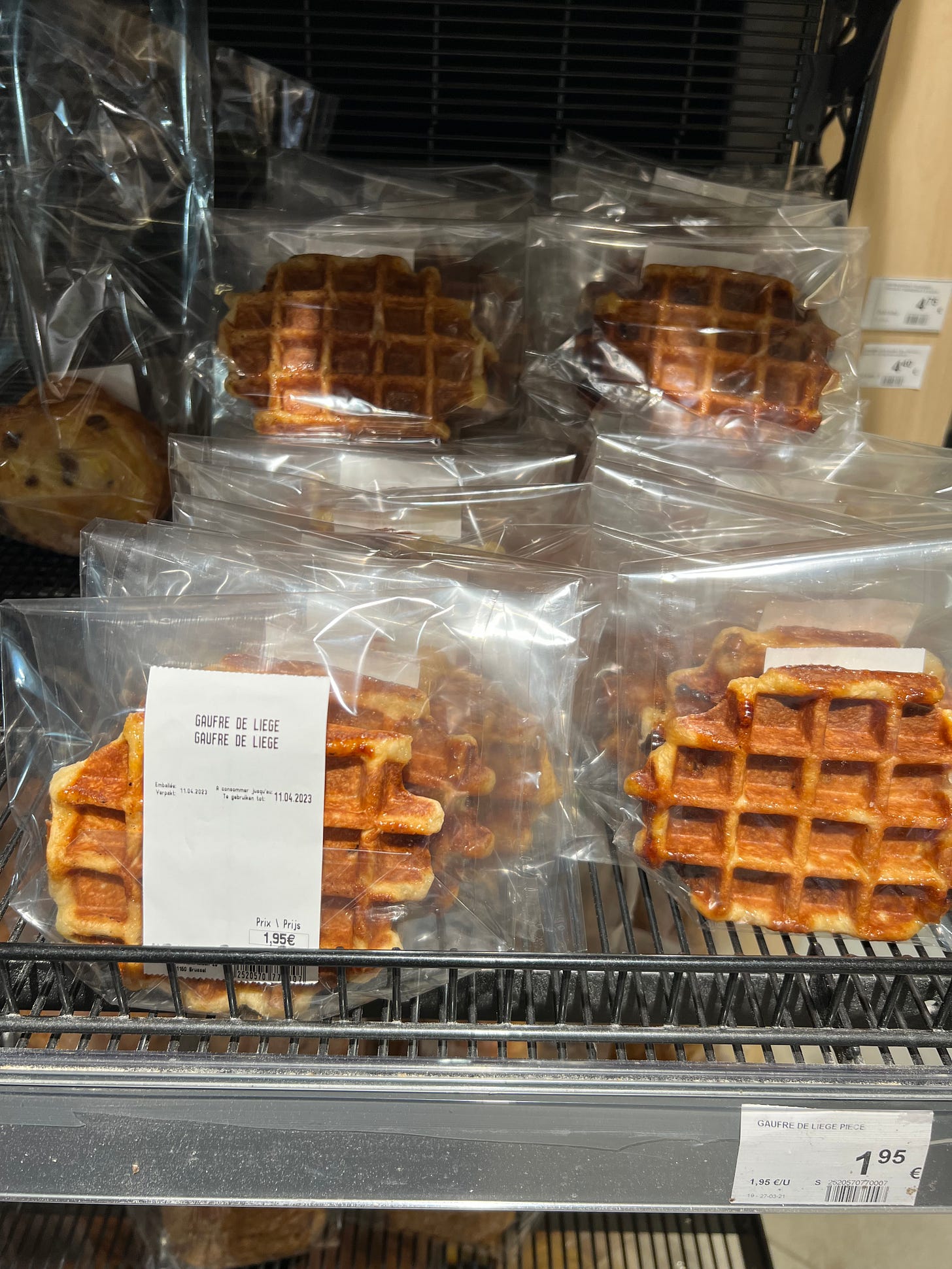
Every few years it seems someone in New York City tries to give Gaufres de Liège their due. In the 1990s, a popular Belgian bistro in Greenwich Village called Le Petit Abeille served a fine Gaufre de Liège, which they imported themselves. They also made Brussels waffles fresh on site. The bistro grew in popularity—soon there was a mini chain—and so did demand for their waffles. But they often ran out of the Liège variety, and then there wouldn’t be any for weeks, sometimes months, until another shipment arrived. Unlike their airy Bruxellois cousins, the Liègeois’s density and high sugar content means they keep and even freeze well and reheat very respectably. Of course, aficionados will tell you only to eat them hot off the iron. And they aren’t wrong.
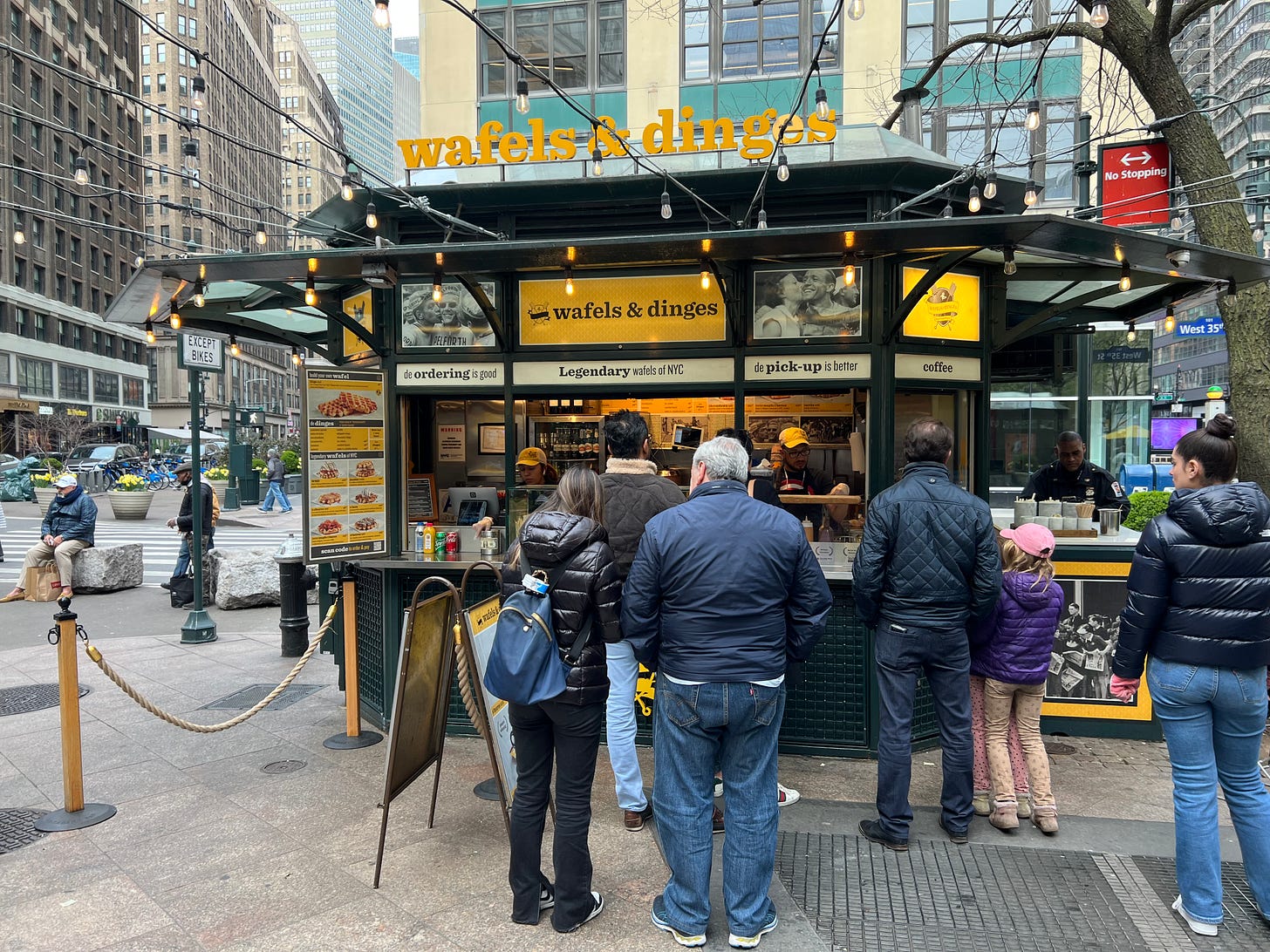
Today, around town you will see food trucks and kiosks bearing the name Wafles & Dinges. Founded by a former finance guy, Thomas DeGeest, these popular spots sell their fair share of fine Gaufres de Liège, which they make themselves in a central facility in Brooklyn. They are quite good. But there is still a long way to go before this style of waffle goes mainstream in America.
At the beginning of the pandemic, I stumbled across a recipe for Gaufres de Liège on the website of a French pastry chef, Rudy Pein, who has a shop in Cénac, outside of Bordeaux. For some reason, perhaps because it seemed easy enough to do and I had the ingredients, or maybe just because it was written in French, I thought these looked like the real deal. So I decided to give them a try.
I was further encouraged to try them because our friend Elia Tello, who works for the US State Department, had recently relocated to Brussels. During the pandemic especially, I cooked foods from around the world both to make like I was traveling and to feel in touch with people I couldn’t see.
My first attempt at Rudy’s gaufres were indeed delicious, especially hot off the iron. I played around a little with the dough, creating a version that used sourdough discard for extra flavor, and the result was also very good. For a time, I kept portioned balls of the dough in our freezer ready to be defrosted and cooked for friends, like a party trick.

When the world opened up a little, we found ourselves in Europe. During a couple of days in Brussels, we had a great, fresh gaufre hot off the iron from Maison Dandoy in the historic center of the city. They were every bit as good as I remembered. And they also confirmed that the ones I made at home were pretty good, too.
Pearls of Waffledom
There is one special ingredient you need to make Gaufres de Liège at home, and that is pearled sugar. Pearled sugar is a type of crystalized sugar that forms small clumps. Because of its structure, it doesn’t melt in the same way as other sugars. In fact, there are different types of pearled sugar, including one popular in Sweden that’s used on top of sweet breads other pastries, and one in Belgium that is used primarily in waffles. Swedish sugar pearls are smaller than Belgian, but I have used them interchangeably in waffles. The pearled sugar in Gaufres de Liège contributes to their dense texture, sweet flavor, and distinctive crunch. I happened to have some pearled sugar when I stumbled on Rudy’s recipe. (I’m always picking up things for the pantry that seem interesting to me even if I don’t know how or when I’ll use them.) But pearled sugar is also super easy to find online. See here.

And now we are back in Belgium, where I am writing this newsletter right now. On our way into town from the airport we stopped at Rob the Gourmet’s Market, an oversized gourmet supermarket, where we picked up a waffle and some pearled sugar to bring home. Though not hot, you could still taste the butter and the caramelized sugar in the waffle.
While discussing where we might have our next waffle, we decided to drive to Liège so we could try them at the source. After triangulating various lists of best Gaufres de Liège in Liège, we got in the car and headed to Waffleland. Upon arriving in Liège, we parked the car under the cathedral and set out on foot. Two places on our waffle route really stood out, André, where the homemade waffles sit alongside a beautiful selection of charcuterie, at what is ostensibly a tiny butcher shop specializing in hand-cut hams on the bone. Here I had my first cinnamon waffle. Oh my! A short walk away was Une Gaufrette Saperlitpopette a charming bakery full of all kinds of buttery baked goods, including exemplary gaufres, available in both vanilla and cinnamon. We deemed our visit to Liège a total success.
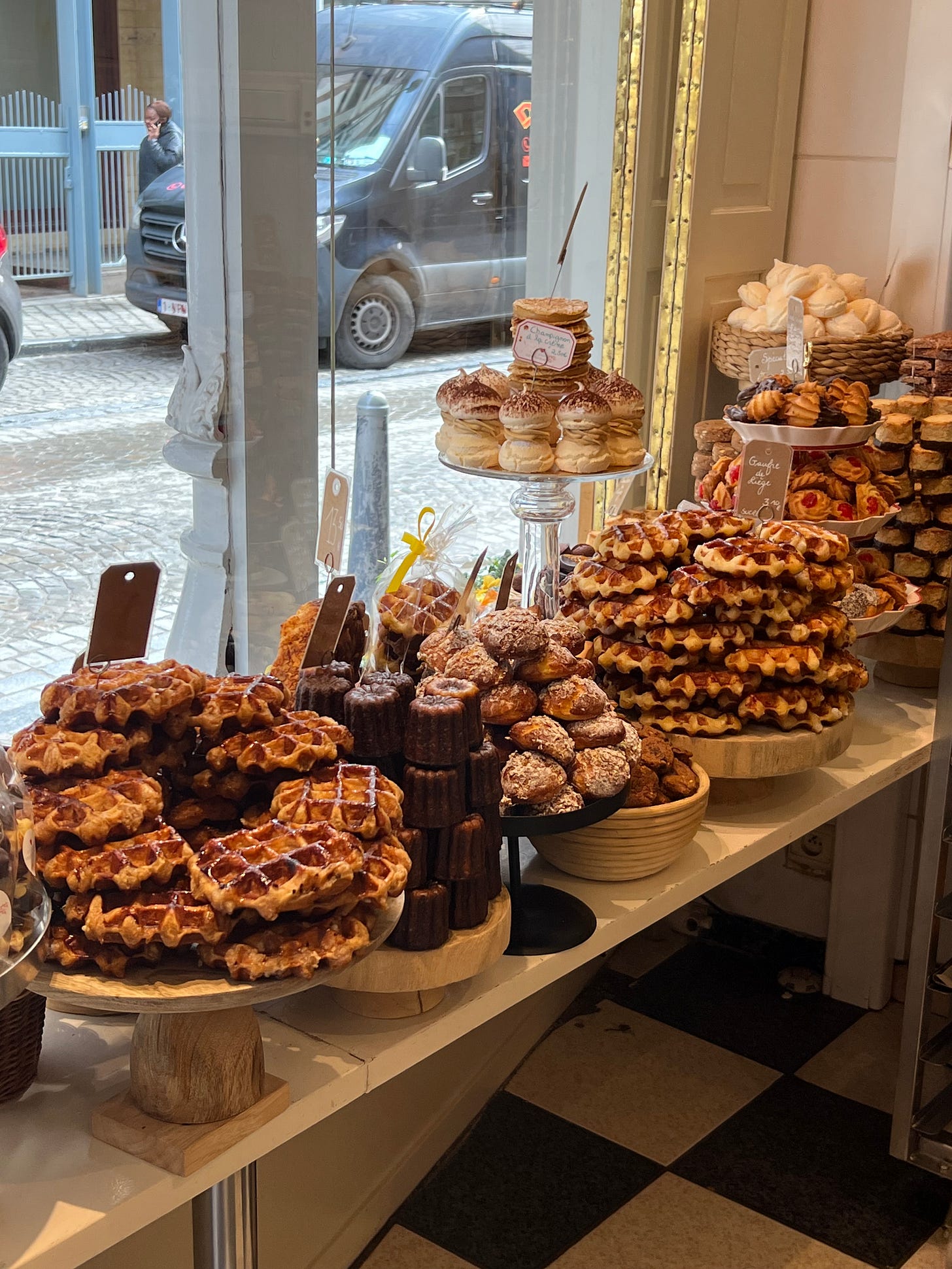
Make Gaufres at Home
Here’s the recipe so you can make Gaufres de Liège yourself. I realize not everyone is going to give this a try. You might be scared off by the need to find Belgian pearled sugar, but it’s easy to order online, and by the fact that I’m giving you the measurements in metric weights, though I’m also including imperial volumes. But if you have a stand mixer and a Belgian waffle iron, I’d encourage you to try it. They really work. They are really delicious. And you will be impressed by the results.

RECIPE: Gaufres de Liège
15g (1 tablespoon) granulated sugar
100g (2/3 cup) all-purpose flour
150g (1 cup) bread flour
2g (scant ½ teaspoon) instant yeast, such as SAF
1 large egg
110g (1/2 cup) whole milk
A good pinch of salt
142g (10 tablespoons, 1 ¼ sticks) unsalted butter, softened, but still somewhat cold (i.e., not room temp)
125g (3/4 cup) Belgian or Swedish pearled sugar
75g (1/2 cup) or so dark brown sugar
In the bowl of a standing mixer, combine the granulated sugar, flours, yeast, egg, and milk. Using the dough hook, work to form a smooth, but stiff dough. It will take a little time to come together and gather up all the flour. Let it knead on low for a good 10 minutes. The dough should form a nice ball on the hook. With the machine running on low, add the butter a chunk or two at a time, until incorporated. This can take some time. The dough will break apart, stick to the sides of the bowl, and then seem like it will never come together again. But it will. Keep going until it comes together. Stop the machine and scrape down the sides of the bowl once in a while. Keep the machine going until the dough comes back together into a nice, smooth, soft ball that only barely sticks to the bottom of the bowl. Maybe as much as 20 minutes. When done, scrape down the sides, cover the bowl with plastic wrap or a clean towel and let rise in a warm-ish (but not so warm that the butter will melt out of the dough) place until double in bulk, which may take 2 hours or more.
When risen, add the pearled sugar and knead it in with the dough hook or by hand for just 15 seconds or so to incorporate and evenly distribute the pearls.
Scale the dough into 8 equal pieces about 90 g (3 ounces) each and shape each piece into a nice ball (see photo). The dough can be refrigerated for 2 or 3 days or frozen for a month or two at this point. Bring it back to room temp before proceeding.
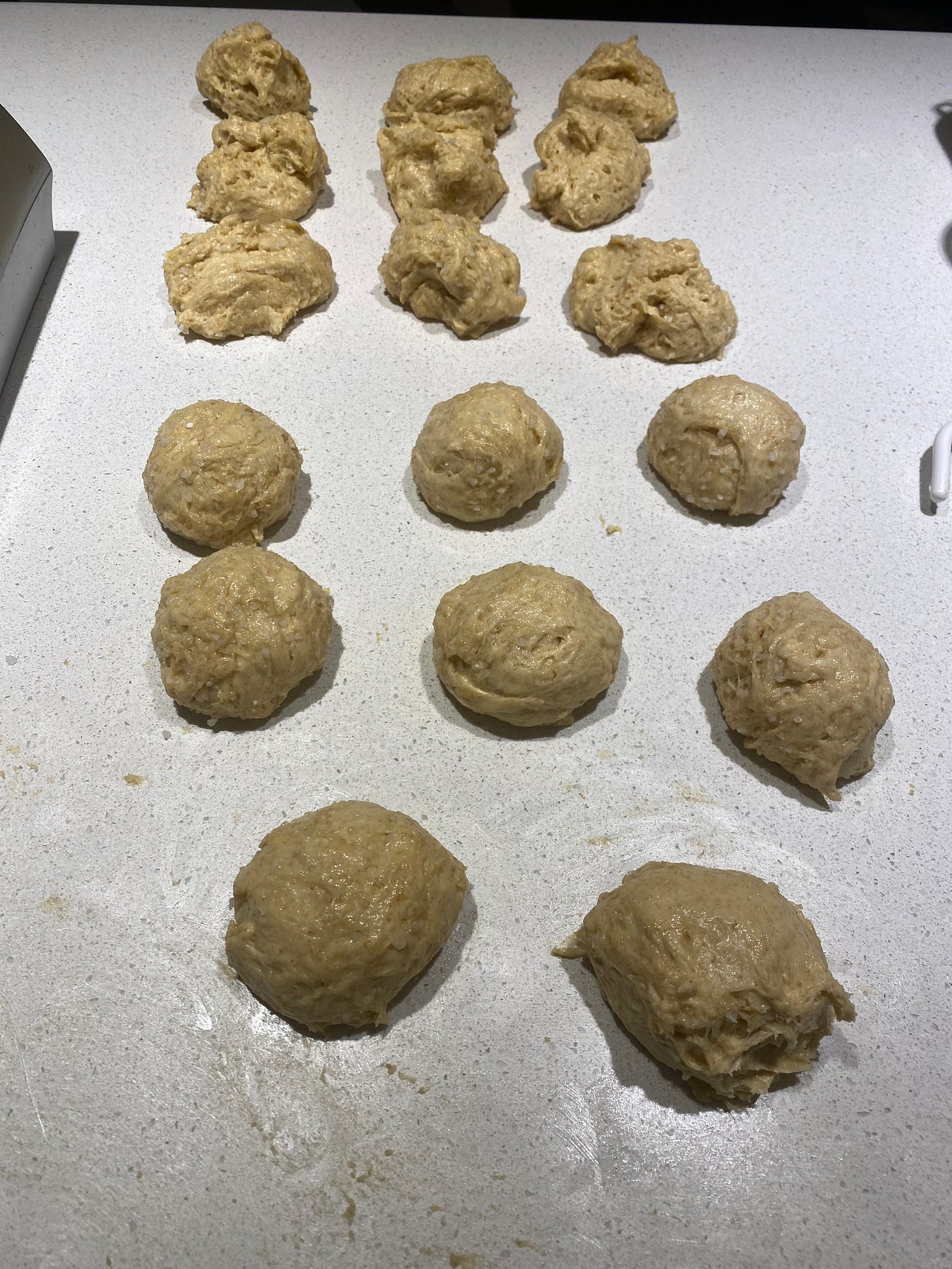
Preheat the waffle iron. Spray the hot iron with pan spray and add one ball of dough. Close the iron (flip, if yours flips) and cook about 3 or 4 minutes, until nicely browned. Open the iron. Sprinkle the top with a light dusting of brown sugar, close, and cook for another 30 to 45 seconds until the sugar melts. Remove from the iron to a rack to cool and repeat with the remaining dough. Be careful, the sugar is hot. Use small tongs, if you have them, or a two-pronged meat carving fork, which is what we saw them use in Liège.
Note, although all that caramelized sugar will make your waffle iron into a scary-looking mess, because of all the butter, it actually cleans rather easily. I use damp paper towel and a chop stick to push it through the grooves.
For a sourdough variation, reduce the milk to 95 g (1/3 cup + 1 tablespoon) and add 145 g (1/2 cup) sourdough starter discard to the batter. Proceed with the recipe as directed.
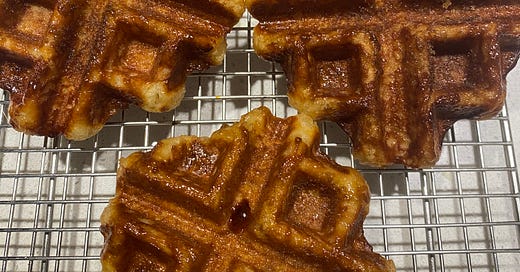



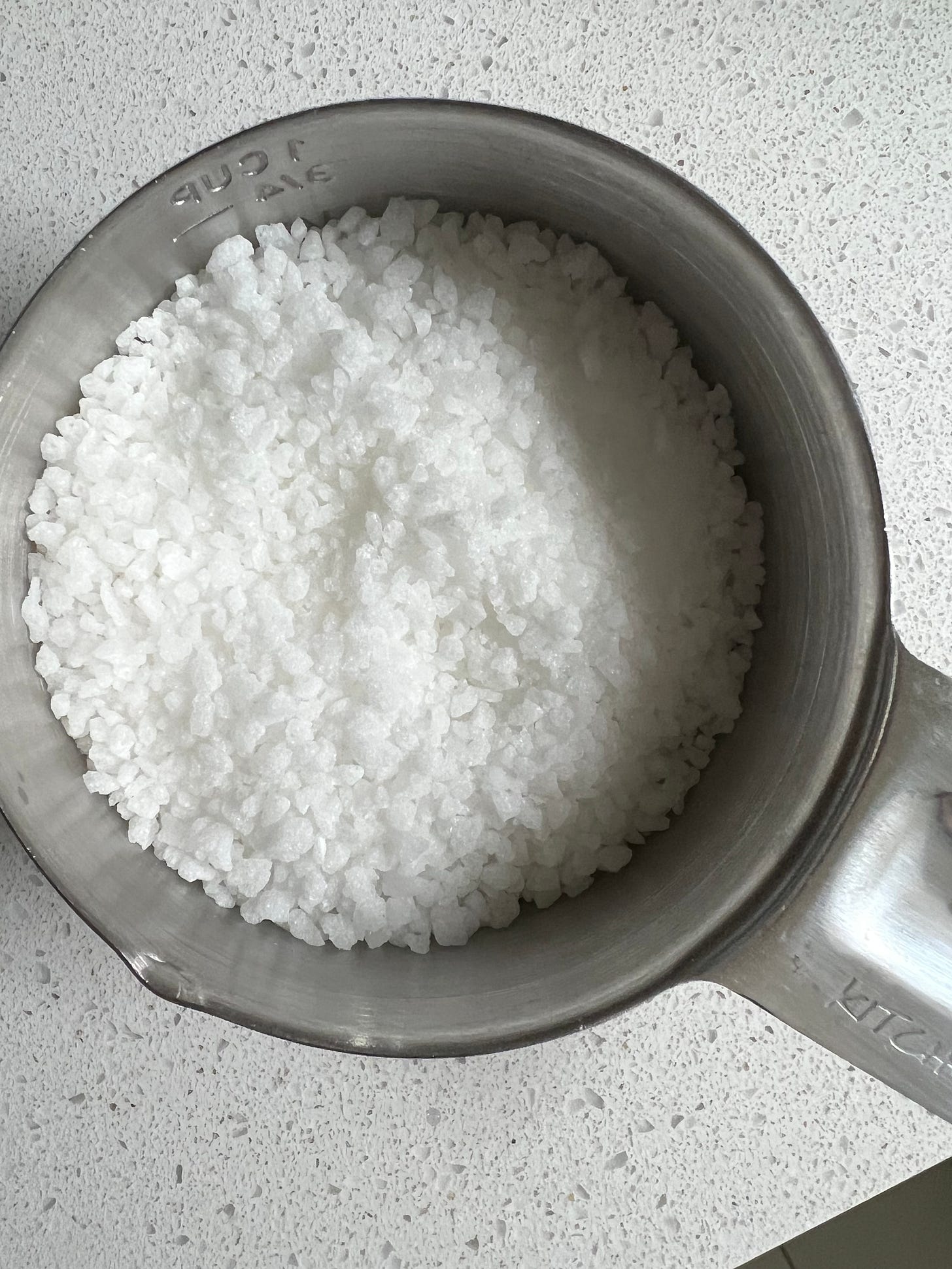
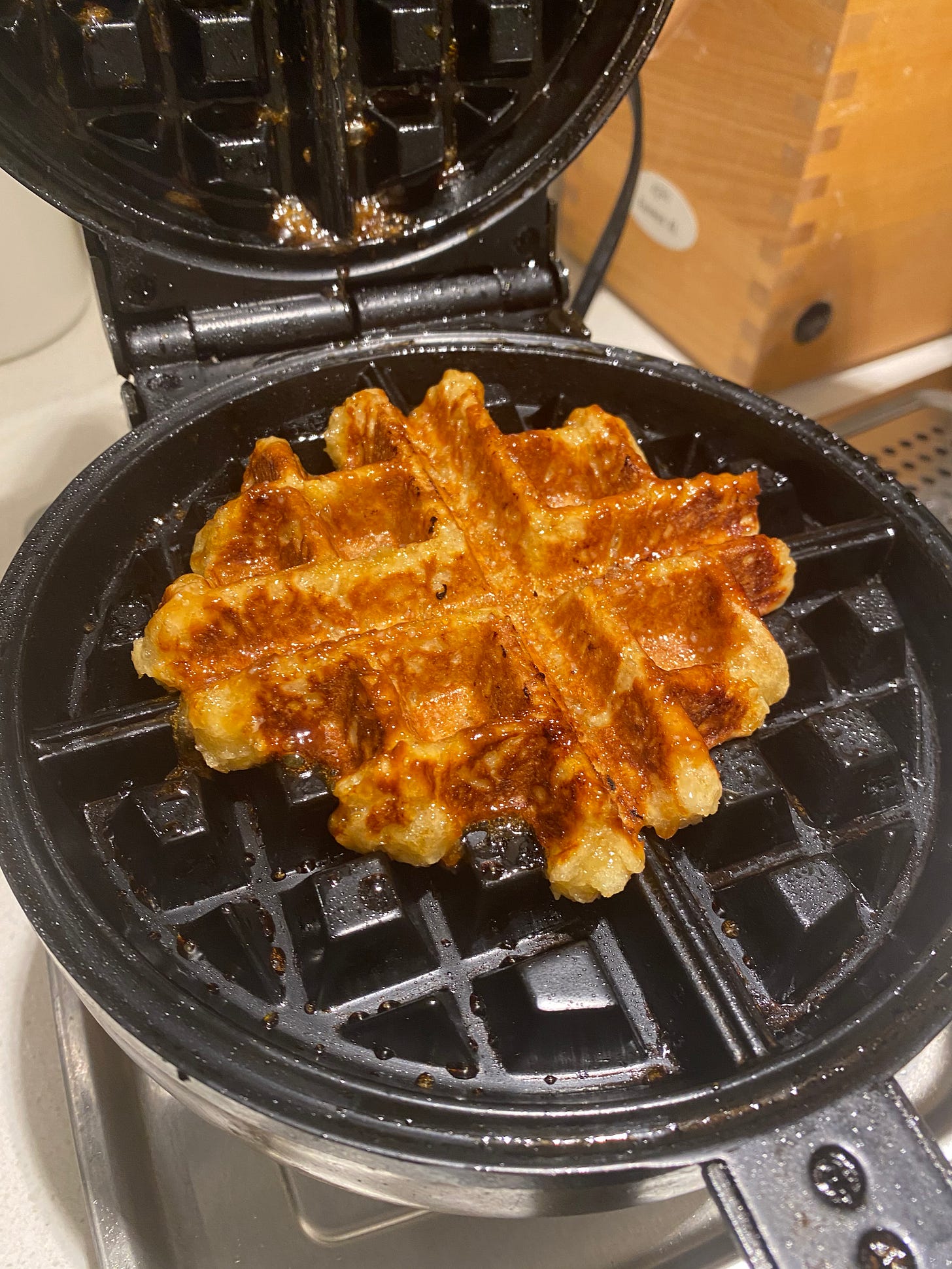
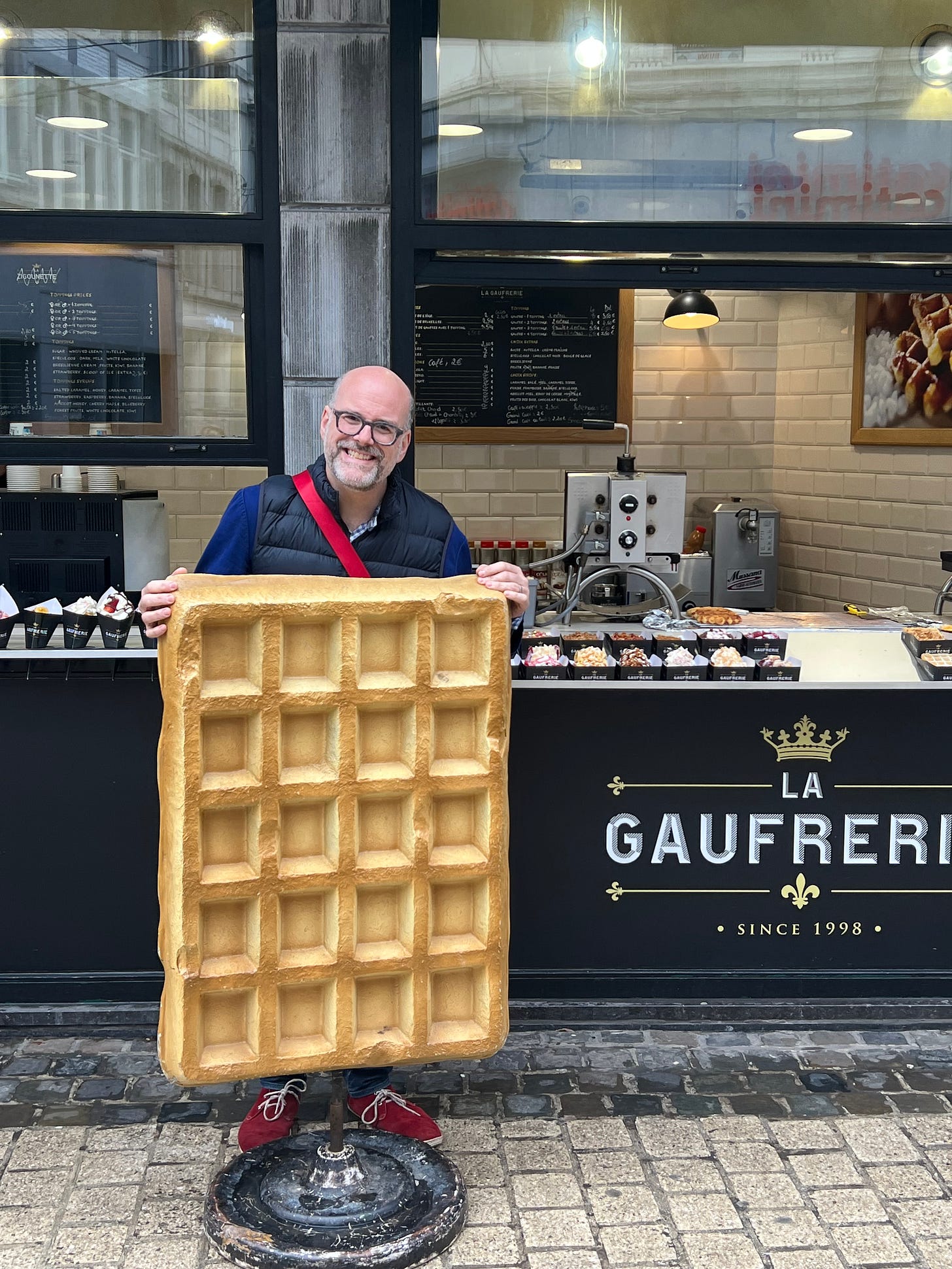
Well, I'm gonna order me some of that pearled sugar and try these out. Not on my diet exactly, but really good for the grandson. Thank you, Mitchell & Dr. Nate too.
Oh I am
Jealous